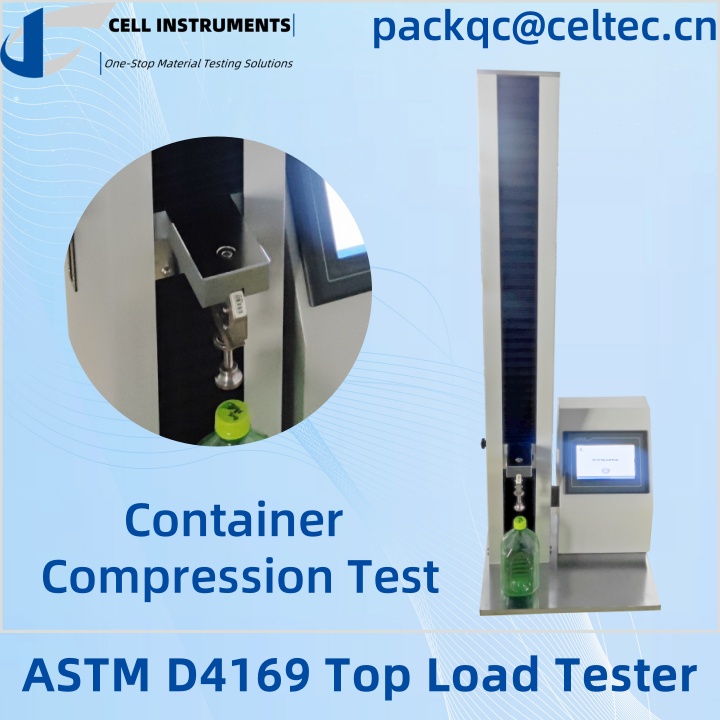ASTM D4169 Top Load Test
Best Container Compression Tester
In the world of packaging and materials testing, ensuring the integrity and durability of containers is crucial. One of the most important tests used to evaluate the strength and performance of containers is the Top Load Test, particularly when adhering to ASTM D4169. This test is designed to simulate real-world conditions, helping manufacturers understand how their packaging will hold up under pressure.
What is the Top Load Test?
The Top Load Test is a compression test used to evaluate the strength and stability of packaging materials, particularly containers such as boxes, bottles, and jars. During this test, a container is subjected to vertical pressure to determine how much weight it can handle before collapsing or losing its shape. The test is designed to replicate the pressure containers face during stacking, transportation, and storage.
By applying pressure to the top of the container, the test assesses the ability of the material to resist deformation or rupture. The Top Load Tester is the primary instrument used for this test, applying controlled force until the container either fails or meets the required strength standards.
ASTM D4169 Testing-Top Load Test
ASTM D4169 is a widely recognized standard for performing top load testing on containers. This standard, developed by ASTM International, outlines specific procedures for simulating various shipping and handling conditions that a container may encounter.
According to ASTM D4169, the test is typically performed in several stages, simulating different environments, including vertical compression and dynamic forces. The standard emphasizes the importance of consistent testing procedures to ensure that packaging designs are reliable and safe for use in commercial and industrial applications.
One key aspect of ASTM D4169 is its focus on different levels of packaging testing. The standard includes provisions for testing various types of packaging, including corrugated boxes, glass containers, plastic bottles, and other forms of packaging used in the transportation and delivery of goods. The top load testing procedure follows a systematic approach to determine whether the containers can withstand stacking pressure and mechanical impacts during transport.
How is Top Load Testing Performed?
The top load test typically involves the following steps:
Preparation of the Test Sample: The container being tested is placed under a Top Load Tester. It is important that the container is filled with product, or a comparable material, to replicate the real-world conditions it will face during shipping.
Application of Pressure: The Top Load Tester applies vertical pressure to the top of the container. This is done gradually to ensure the test replicates the typical stacking conditions experienced during transportation.
Monitoring and Measurement: The force applied is monitored carefully, and the test continues until the container either fails (ruptures, deforms, or collapses) or the desired strength threshold is met.
Results and Analysis: The results of the test are analyzed to determine the packaging’s ability to withstand stacking forces. If the container meets the strength requirements outlined in ASTM D4169, it is considered suitable for use in real-world shipping environments.
Why is Top Load Testing Important?

Top load testing is essential for several reasons:
Ensuring Container Strength: Containers are often subjected to substantial forces during transportation, especially when stacked in warehouses or on pallets. The top load test ensures that packaging materials can withstand these stresses without failing.
Compliance with Industry Standards: ASTM D4169 sets clear guidelines for top load testing, helping manufacturers comply with industry standards. Adherence to these guidelines ensures the safety and reliability of packaging materials, which can improve customer satisfaction and reduce the risk of product damage during transit.
Reducing Costs and Waste: By using top load testing, manufacturers can optimize their packaging design to reduce material costs and minimize product loss due to container failure. Testing can also help eliminate the need for expensive recalls and reduce waste caused by damaged goods.
Improving Packaging Designs: The ASTM D4169 testing procedure provides valuable data that can be used to refine packaging designs. Whether it’s adjusting the thickness of a cardboard box or changing the shape of a plastic bottle, top load testing helps manufacturers create more reliable packaging.
